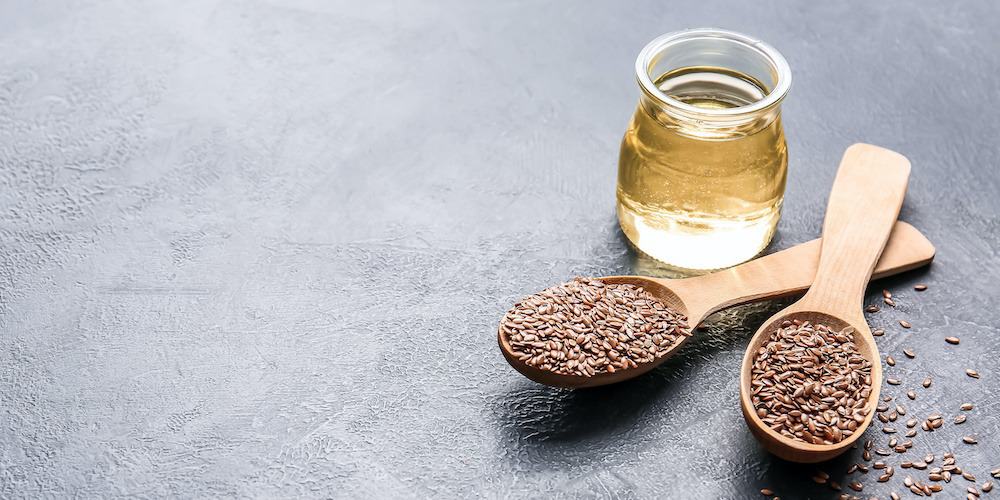The benefits of flaxseed oil
Flaxseed oil, what is it ?
It is obtained by pressing the seeds of Linum usitatissimum or “cultivated flax”. Like soy or nigella, this plant produces oilseeds, which are very rich in oil.
Harvested at maturity, they are pressed to extract a vegetable oil : flaxseed oil, also called “oil of flax seeds“.
It is characterized by a beautiful golden-yellow color, a cereal-like aroma and a slightly bitter taste. It is an oil that is both culinary and cosmetic. In cooking, it is used to dress cold dishes.
It is also recommended for face, body and hair care. Finally, it can be taken in capsules, as a dietary supplement.
The benefits of flax seeds
These seeds consist of about 40 % fatty acids (omega-3-6-9). They also contain vitamin E and a wide variety of B vitamins (B1, B2, B3, B5, B6 and B9). Not to mention the minerals and trace elements : calcium, copper, iron, magnesium…
Finally, they are a source of plant proteins, amino acids, and fiber.
Flaxseed oil has a very good omega-3/omega-6 balance. It is particularly rich in alpha-linolenic acid (56 g per 100 ml), an omega-3 that even gave it its name. Thus, it partly meets daily requirements for essential fatty acids.
Read also | Everything you need to know to choose the right omega-3s
This balanced ratio also gives it benefits for the heart. As shown by this study, it contributes to cardiovascular health.
Finally, it is credited with anti-inflammatory properties, anti-cancer properties, and a positive effect on the nervous system and emotional balance.

How to choose your flaxseed oil?
Opt for an organic-certified oil
We recommend choosing a certified organic oil. The seeds used come from flax grown in organic farming. This guarantees an oil free of pesticide residues or chemicals.
Also opt for a 100 % virgin oil, pure, non-GMO, without additives or preservatives.
Other quality criteria
Choose a vegetable oil obtained from a first cold pressing. Cold extraction, performed below 27°C, preserves the active compounds and properties of flax seeds. Thus, it guarantees a nutritious, high-quality oil.
France produces about 50,000 tons of seeds each year. If you can, buy an oil made from flax of French origin and grown locally.
How to use flaxseed oil?
In cooking
Excellent edible oil, it is ideal for seasoning cold dishes and no-cook preparations without cooking : salads, tabbouleh, sauces, vinaigrettes, gazpachos…
Indeed, it cannot stand heat at all. Its nutty flavor pairs well with cheeses and desserts such as the carrot cake.
Warning: this oil is fragile and sensitive to oxidation. It goes rancid quickly, loses its nutritional qualities and becomes unfit for consumption. It should therefore be stored in the refrigerator and consumed quickly (within 6 months).
As a dietary supplement
Flaxseed oil can be consumed as a dietary supplement, in capsule form. It is a good alternative to fish oils for supplementing omega-3s.
This format makes it easy to take and has the advantage of not carrying the bitter taste of flaxseed oil. In addition, encapsulation protects the oil from oxidation.

For skin care
Rich in vitamin E, it protects against free radicals that accelerate aging. It has a reparative effect, supports the skin’s elasticity and suppleness. It is an excellent anti-aging oil and anti-wrinkle oil.
Moreover, it nourishes, strengthens the skin barrier, promotes healing and cell regeneration. It is ideal for mature, dry, sensitive or damaged skin.
This oil is applied by massage, directly to the skin of the face and/or body. It can be used alone or in combination with other vegetable oils: wheat germ, hazelnut, chia…
Its fluid texture penetrates quickly. Thanks to its dry feel, it does not leave a greasy film.
For hair care
Rich in fatty acids, it deeply nourishes and protects against external aggressions. In addition, it coats the hair shaft to restore vitality to dull, damaged, and fine hair.
Finally, it defines the curls of curly or frizzy hair. It is very suitable for dry scalps, irritated or prone to dandruff.
You can use it as a hair mask or in an oil bath. Apply it directly to dry hair, focusing on the ends and lengths. Complete its action with another vegetable oil suitable for your hair type: grapeseed, castor, argan…




